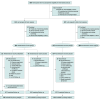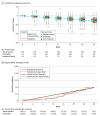Conflict of Interest Disclosures: Dr Shefner reported receiving grants from National Institute of Neurological Disorders and Stroke (NINDS), Mitsubishi Tanabe, Sean M. Healey & AMG Center for ALS, Sanofi, PTC, and NeuroSense; and personal fees from Novartis, PTC, NeuroSense, Amylyx, and Acurastem outside the submitted work. Dr Oskarsson reported receiving grants from Massachusetts General Hospital during the conduct of the study; grants from Columbia University/Tsumura, MediciNova, Biogen, Mitsubishi Tanabe, Cytokinetics, Calico, Sanofi, Ashvattha, Target ALS, and NINDS; and personal fees from uniQure and Amylyx outside the submitted work. Dr Macklin reported receiving grants from AI Therapeutics, Alector, Biohaven, Calico, Clene, Denali, ITB-MED, Lilly, Mitsubishi Tanabe, PharmAust, Revalesio Corporation, Seelos, and UCB/Ra Pharmaceuticals paid to institution; personal fees for serving on the advisory boards of Annexon Biosciences, BIAL, Cortexyme, Chase Therapeutics, Enterin, Hillhurst, Merck, nQ Medical, and Partner Therapeutics; personal fees for serving on the steering committees of Biogen, Stoparkinson, UCB, and argenx; and personal fees for being a data and safety monitoring board (DSMB) member of NeuroSense, Novartis, and Sanofi outside the submitted work. Dr Quintana reported receiving personal fees from Berry Consultants during the conduct of the study. Dr Saville reported being the owner of and receiving personal fees from various companies via Adaptix Trials outside the submitted work. Dr Detry reported consulting fees paid to Berry Consultants from Sean M. Healey & AMG Center for ALS during the conduct of the study. Dr Vestrucci reported consulting fees paid to Berry Consultants from Sean M. Healey & AMG Center for ALS during the conduct of the study. Dr Marion reported receiving personal fees from Berry Consultants during the conduct of the study. Dr McGlothlin reported consulting fees paid to Berry Consultants from Sean M. Healey & AMG Center for ALS during the conduct of the study. Dr Heiman-Patterson reported receiving grants from Sean M. Healey & AMG Center for ALS during the conduct of the study; grants from Mitsubishi Tanabe, Amylyx, ALS Association, Muscular Dystrophy Association, Samus, Alexion, and UCB; personal fees for serving on the medical advisory boards of Mitsubishi Tanabe, Amylyx, and Novartis; and personal fees from p-value group, Projects In Knowledge, and Vindico Medical Education outside the submitted work. Ms Chase reported receiving grants from UCB, Biohaven, and Clene during the conduct of the study. Mr Sherman reported receiving grants from US Food and Drug Administration (FDA), National Institutes of Health (NIH), Biogen, Mitsubishi Tanabe, Amylyx, and ALS Association outside the submitted work. Dr Berry reported receiving personal fees from Alexion, Amylyx, Biogen, Mitsubishi Tanabe, Roon, Regeneron, and Sanofi; and grants from Alexio, Amylyx, Mitsubishi Tanabe, Biogen, Rapa Therapeutics, BrainStorm Cell Therapeutics, and uniQure outside the submitted work. Dr Babu reported receiving grants from NIH/NINDS; research funding from Ionis, Biogen, Novartis, OrphAI, and Denali; consulting fees to institution from uniQure and MarvelBiome; and honoraria from NIH and American Academy of Neurology outside the submitted work. Dr Andrews reported receiving grants to institution from Biogen, Cytokinetics, Amylyx, NIH/NINDS, Calico, Denali, and Prilenia Therapeutics; personal fees for serving on the DSMBs of AL-S Pharma, Sanofi, and QurAlis; and personal fees for serving on the scientific advisory board of NeuroSense and AKAVA outside the submitted work. Dr Alameda reported receiving a principal investigator stipend from Sean M. Healey & AMG Center for ALS during the conduct of the study. Dr Ho reported receiving research funding from Ra Pharmaceuticals, Biohaven, Calico, Seelos, Denali, Biogen, Transposon, Sanofi, Neurodegenerative Alzheimer’s Disease and Amyotrophic Lateral Sclerosis basket trial, and Genentech; and personal fees for serving on the advisory boards of Sanofi, Alexion, and Biogen outside the submitted work. Dr Ajroud-Driss reported receiving personal fees from Amylyx and Biogen during the conduct of the study. Dr Heitzman reported receiving grants from Muscular Dystrophy Association and ALS Association; study support from NINDS, AbbVie, AbbVie/Calico, Anelixis, Amylyx, Biohaven, Cytokinetics, Denali, Abcuro, Immunovant, Clene, Mitsubishi Tanabe, Neurologix Foundation, Ra Pharmaceuticals, and Seelos; and personal fees from University of Texas and Amylyx outside the submitted work. Dr Shroff reported receiving personal fees from UCB, Alnylam, argenx, and AstraZeneca outside the submitted work. Dr Maragakis reported receiving grants from NIH/NINDS and US Department of Defense Amyotrophic Lateral Sclerosis Research Program during the conduct of the study; personal fees from Nura Bio, Novartis, and AKAVA; and nonfinancial support from Janssen and Secretome Therapeutics outside the submitted work. Dr Simmons reported receiving grants from Massachusetts General Hospital during the conduct of the study; personal fees from Biogen, Amylyx, Insmed, Corcept, and Columbia University; and grants from Sanofi and Clene outside the submitted work. Dr Miller reported receiving personal fees from Ionis Pharmaceuticals, Biogen, Arbor Biotechnologies, and BIOIO; licensing agreements from Ionis Pharmaceuticals and C2N; and honorarium from Denali outside the submitted work. Dr Weiss reported receiving personal fees from Biogen, Cytokinetics, Mitsubishi Tanabe, Amylyx, and Sanofi outside the submitted work. Dr Vu reported receiving reimbursement from University of South Florida Department of Neurology during the conduct of the study. Dr Ilieva reported receiving grants from ALS Association during the conduct of the study; and grants from TechVsALS outside the submitted work. Dr Arcila-Londono reported receiving grants from ALS Association outside the submitted work. Dr Ladha reported receiving personal fees from Sanofi, Biogen, Amylyx, and Genentech outside the submitted work. Dr Elliott reported receiving grants from Denali, Calico, AbbVie, Seelos, Biohaven, UCB, MediciNova, and ALS Association outside the submitted work. Dr Bedlack reported receiving grants from Duke during the conduct of the study. Dr Walk reported receiving personal fees from Mitsubishi Tanabe, Amylyx, and Clene outside the submitted work. Dr Johnson reported receiving personal fees from argenx outside the submitted work. Dr Goyal reported receiving grants from Abcuro, Amylyx, Annexon, Calico, Clene, Cytokinetics, Fulcrum, Janssen, Kezar, MediciNova, Mitsubishi Tanabe, PepGen, PTC, Roche, Sanofi, and Transposon outside the submitted work; and serving on the speakers’ bureau for argenx and CSL Behring. Dr Benatar reported receiving consulting fees from Prilenia Therapeutics, Alector, Biogen, Novartis, Bristol Myers Squibb, Woolsey, Eli Lilly, uniQure, and Arrowhead outside the submitted work. Dr Shah reported receiving grants from Abcuro, Muscular Dystrophy Association, and argenx outside the submitted work. Dr Beydoun reported receiving grants from University of Southern California during the conduct of the study; grants from Abcuro, Janssen, Sanofi, and Regeneron; and personal fees from argenx, Alnylam, AstraZeneca, Alexion, CSL Behring, UCB, and Takeda outside the submitted work. Dr Wymer reported receiving grants from Mitsubishi Tanabe outside the submitted work. Dr Nayar reported receiving personal fees from Sanofi outside the submitted work. Dr Leitner reported receiving personal fees from ALS Investment Fund outside the submitted work. Dr Goldberg reported owning shares in Prilenia Therapeutics. Dr Geva reported a patent (WO/2019/036358) issued. Dr Hayden reported being the Chief Executive Officer of Prilenia Therapeutics outside the submitted work; and owning patents (20240148708, 20230190724, 11406625, 20210030734, 20200179355). Dr Paganoni reported receiving grants from Amylyx, Eledon, Alector, Seelos, Calico, Denali, NIH, US Centers for Disease Control and Prevention, and US Department of Defense; consulting agreements from Amylyx, Revalesio Corporation, Bristol Myers Squibb, Clene, Prilenia Therapeutics, Eikonizo, Sola, and PharmAust; personal fees from Arrowhead, Biogen, Johnson & Johnson, Merck, and Cytokinetics; and being a speaker for PeerView, Medscape, and i3 Health outside the submitted work. No other disclosures were reported.



